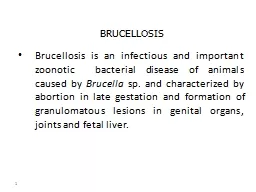

zoonotic bacterial disease of animals caused by Brucella sp and characterized by abortion in late gestation and formation of granulomatous lesions in genital organs joints and fetal liver ID: 913159
Download Presentation The PPT/PDF document "1 Brucellosis is an infectious and impo..." is the property of its rightful owner. Permission is granted to download and print the materials on this web site for personal, non-commercial use only, and to display it on your personal computer provided you do not modify the materials and that you retain all copyright notices contained in the materials. By downloading content from our website, you accept the terms of this agreement.
Slide1
1
Brucellosis is an infectious and important zoonotic bacterial disease of animals caused by Brucella sp. and characterized by abortion in late gestation and formation of granulomatous lesions in genital organs, joints and fetal liver.
BRUCELLOSIS
Slide2Incidence
1863 – Marstion was described Brucellosis in the islands of Malto.1887 – Sir
Robert
Bruce found the bacilli from Spleen of infected
soldier. Later on they isolated in the pure cult(
Micrococcus
mellitensis
)
1897 –
Bange
isolated and identification of organism in aborted
cow
fetuses
and
fetal
membrane & named the organism
Brucella
abortus
.
(
Bang Disease)
1913 –
Traum
isolated & identification
of
Brucella
suis
in pigs
1951 –
Bubdle
and
Boyes
isolaed
Brucella
ovis
in rams
1968 –
Charnecael
isolated
Bruella
canis
in dogs
Slide3Etiology ( 7 species till now in the world)
Brucella abortus ( pathogenic strains in India is 544) in America it is
2308.
The
vaccine stain in India Cotton strain 19 ( S19
).
& in America is
RB 51
. Live vaccine (Br. is an intracellular organism
) kill vaccine is not effective.
Br.
ovis
Br.
m
eletensis
– 16 M in India vaccine strain
Rev-1
Br.
c
anis
Br.
s
uis
Br.
n
eotomiea
(wood rat)
Br.
m
aris
( marine animal)
Slide4Resistance to physical & chemical agents
In 60oc temp. for 10 mint the organism can not survive, pasteurization of milk kill the Brucella.Every disinfectant & detergents are lethal to Br.Low pH is lethal to Br & Direct sunlight is lethal.The organism can be store at 4-8oc upto 1 yr.
Slide5Prevalence
The prevalence of Brucellosis throughout the world.In India, the prevalence rate from 6.6 % in M.P 60% and North Eastern state.
Slide6Many Names of Brucellosis
Human DiseaseMalta Fever
Undulant Fever
Mediterranean Fever
Rock Fever of Gibraltar
Gastric Fever
Animal Disease
Bang’s Disease
Enzootic Abortion
Epizootic Abortion
Slinking of Calves
Ram
Epididymitis
Contagious Abortion
Slide7HOST RANGE and TRANSMISSION
Brucella abortus : cattle, buffalo, select wildlife Brucella melitensis
:
sheep, goats and bovines
Main source of infection
uterine discharge of infected animals
aborted foetus
infected semen
Spreads mainly through
ingestion of contaminated food and water
Artificial Insemination
tail splashing of urine - conjunctival route
veterinary activities
Rural poor zoo sanitary conditions
Slide8IMPORTANT OUTCOME OF INFECTION
Sexually mature animals only affected Initial exposure infection during: in pregnancy
Slide9We regard brucellosis as
the World’s most Widespread of all Zoonoses & it has Enormous Impact on the
Animals Industry
Slide10Species
Biotype
Animal Hosts
First Described
B. melitensis
1-3
Goats, sheep, camels
Bruce, 1887
B. abortus
1-6, 9
Cows, Camels, Yaks, buffalo
Bang, 1897
B. suis
1-5
Pigs (biotypes 1-3), wild hares (biotype 2), caribou and reindeer (biotype 4 ), rodents (biotype 5)
Traum, 1914
B. canis
-CaninesCarmichel and Bruner, 1968B. ovis-SheepVan Drimmelen, 1953B. neotomae-RodentsStoenner and Lackman, 1957B. pinnipediae and B. cetaceae or B. Maris (provisional)-Mink whales, dolphins, porpoises (pinnipediae), seals (cetaceae)Ewalt and Ross, 1994
Non-zoonotic ??
Slide1111
Pathogenesis Ingestion, Inhalation Enter through intact or abraded skin or conjunctivaeCongenital infection Bacteria multiply in regional lymph nodesTravel through lymphatics
BRUCELLOSIS
Slide1212
Pathogenesis Affinity with female and male reproductive organsLocalize in lymph nodes, spleen, liver, joints, bonesProliferates intracellularlyHigh affinity with erythritol in placenta and foetusAbortions in animals in late gestation
BRUCELLOSIS
Slide13In case of cow, the site of predilection is placental trophoblast. It contain erythrotol, higher affinity to
erthotol direct the organism to replicate the trophoblast( outer layer of blastocyst).The increase hydrophobicity of the outer membrane protein causes the utilization of the hydrophobic nutrients of the trophblast. The placental trophoblast will secrete some hormones like cortisol, PGF2alfa, Estrogen and other steroid hormone.
The increase amount of estrogen,
PGF2
alfa
coupled with decrease amount of progesterone, terminate the pregnancy 5-7 month of gestation.
Slide14Clinical signs
Clinical signsCattleAbortion in 7th and 8th months of gestationPersistent infection in cows exposed after pubertyPigsTransmission through coitus.Abortion in 2nd and 3rd months of gestationOrchitis
in infected boars
Localization in other tissues like skeleton more common
Slide15Clinical signs
Sheep and goatsTransmission same as cattleAbortion in ewesOrchitis, epididymitis in male sheep and goats.DogsCaused by B. canisTransmitted by exposure to uterine discharges or aborted fetuses or by coitus.Abortion in 50 days of gestationMale dogs –
orchitis
/
epididymitis
.
Horses
B.
abortus
+
Actinomyces
bovis
Slide1616
Characteristic symptoms OrchitisAccumulation of fluid in scrotumAbortion in late gestation (7-9 month) 3
rd
trimester of pregnancy.
Retention of placenta
BRUCELLOSIS
Slide1717
Macroscopic features Oedema of chorion, thickened Oedema of foetus, serosan-guinous fluid in body cavityPneumonia, necrotic foci in liverEnlargement of scrotum in malesInduration of mammary gland in cows
BRUCELLOSIS
Slide18Orchitis
Slide19Abortion
Slide20Retained Placenta
Slide2121
Microscopic features Infiltration of phagocytic cells, epithelioid cells and lymphocytes surrounded by fibrous tissue proliferationFetal broncho pneumoniaOrganism in chorionic epithelial cellsIn males, proliferation of fibrous tissue compresses or replaces epididymis
BRUCELLOSIS
Slide2222
Diagnosis Symptoms and lesionsMilk ring test (MRT)Immunodiagnostic tests- CFT, SAT, ELISA, DIAIsolation of bacteria
Demonstration of organisms in tissue sections using special stains
BRUCELLOSIS
Slide23Slide24Simple
agglutiation test cannot differentiate B. abortus and B. Melinensis.Agglutinin absorption tecnique is required to defferetiate B. abortus & B. melitensis.